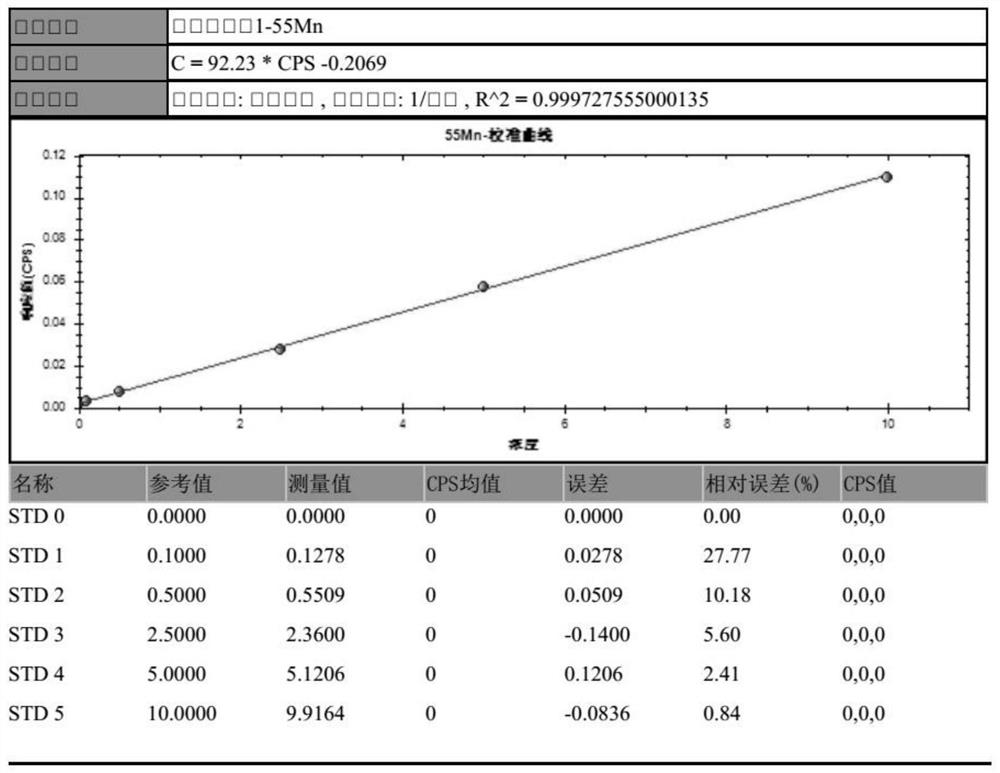Method for detecting six trace elements in whole blood by using internal standard combined solution
An internal standard element and solution technology, applied in measurement devices, instruments, scientific instruments, etc., can solve problems such as the application of trace elements affecting the detection of blood, the excessive number of internal standard combinations, and the reduction of sensitivity, so as to reduce human operation errors, prepare Simple operation and high sensitivity
- Summary
- Abstract
- Description
- Claims
- Application Information
AI Technical Summary
Problems solved by technology
Method used
Image
Examples
Embodiment 1
[0080] Embodiment 1: Preparation of internal standard calibrator of manganese element in human whole blood
[0081] (1) 1% HNO 3 : Measure 5mL of HNO 3 , dilute to a 500mL volumetric flask with purified water, and mix well;
[0082] (2) Preparation of sample diluent: measure 0.5mL of HNO 3 , 0.5mL of Triton, 10mL of isopropanol were distilled to a 500mL volumetric flask with purified water, and mixed;
[0083] (3) Manganese internal standard calibration product preparation in human whole blood: the single element standard solution of germanium Ge and scandium Sc is diluted 100 times with 1% HNO3, the total volume is 10mL, and the concentration is 10mg / L to obtain the manganese element in human whole blood Internal standard stock solution; then take 0.4mL human whole blood manganese element internal standard stock solution and dilute it 100 times with sample diluent, the total volume is 100mL, the concentration is 40μg / L, and the human whole blood manganese element internal ...
Embodiment 2
[0084] Embodiment 2: Calibrate the trace element analyzer with internal standard calibrator
[0085] The purpose of the experiment: to calibrate and optimize the repeatability and stability of the trace element analyzer (Clin-ICP-QMS-I) by using the internal standard calibrator.
[0086] experimental method:
[0087] (1) Put the internal standard calibration product at room temperature (10-30°C), shake well and set aside.
[0088] (2) When testing, inject the internal standard calibrator and external standard calibrator (or quality control product, or unknown sample) at the same time.
[0089] (3) Adjust the parameters of the trace element analyzer (Clin-ICP-QMS-I) to the best state according to the instrument operating procedures. After the instrument is stabilized, the internal standard calibrator and the external standard calibrator are injected at the same time, and the external standard calibrator is injected sequentially (from No. 0 to No. 5). Each sample needs to cons...
Embodiment 3
[0091] Example three: detection of manganese element content in 116 cases of human whole blood samples
[0092] experimental method:
[0093] 1. Sample collection and storage
[0094] (1) The blood collection personnel should try not to wear latex gloves when collecting blood. They can use plastic gloves, or clean their hands without gloves; Wipe the iodine with alcohol); (2) Collect about 2mL of whole blood using a sodium heparin anticoagulant blood collection tube, make sure the cap is tightly closed, and immediately mix by inverting gently to avoid coagulation. If it cannot be submitted for inspection within 2 hours, it should be stored at 2-8°C for a maximum of 14 days.
[0095] 2. Sample pretreatment
[0096] Dilute 20 times: Whole blood sample (>200μL) is mixed with a blood mixer for 5-8 minutes, pipette 100μL blood sample into a centrifuge tube containing 1.9mL diluent with a calibrated pipette gun, and place in a vortex Mix well on the shaker and wait for testing o...
PUM
| Property | Measurement | Unit |
|---|---|---|
| concentration | aaaaa | aaaaa |
| concentration | aaaaa | aaaaa |
Abstract
Description
Claims
Application Information
 Login to View More
Login to View More - R&D
- Intellectual Property
- Life Sciences
- Materials
- Tech Scout
- Unparalleled Data Quality
- Higher Quality Content
- 60% Fewer Hallucinations
Browse by: Latest US Patents, China's latest patents, Technical Efficacy Thesaurus, Application Domain, Technology Topic, Popular Technical Reports.
© 2025 PatSnap. All rights reserved.Legal|Privacy policy|Modern Slavery Act Transparency Statement|Sitemap|About US| Contact US: help@patsnap.com



